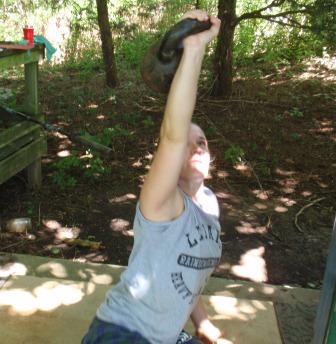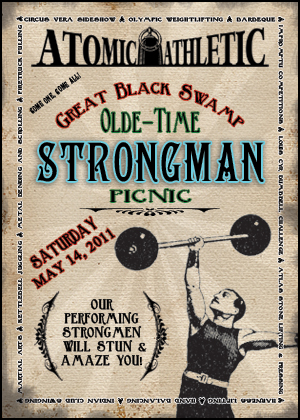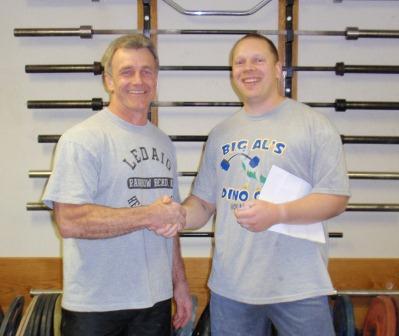by Larry Traub
Part one – Artificial Strength

Larry Traub performing a squat in a powerlifting competition.
Without a doubt, the thing that troubles me the most about the direction our sport has taken is the amazing lifts that are being posted that are not representative of the athlete’s natural ability or hard work. There are two separate issues here that result in what I would call artificial strength. The first one is the use of strength inducing drugs and the second is the use of equipment that spring loads the body.
The pharmaceutical end of this has been around for a long time and that’s a tough nut to crack. My association with The USAPL/IPF leads me to believe that they are being as diligent as possible in keeping drugs out of their organization. As a lifetime drug free lifter I fully appreciate the fact that they are creating a situation where I can minimize the possibility of having to compete against someone who is using drugs to enhance their lifting. There is always the old argument that since drug testing is imperfect that the only fair way to run a contest is to have no drug testing. There may be some truth to this, but if I choose not to use drugs, I would rather lift in an organization which encourages drug free lifting and discourages and penalizes the use of performance enhancing drugs. Ideally, I feel that there should be two organizations. There should be one that has no drug testing and one that employs the best testing methods available. The need for the other 10-15 organizations that we have is very questionable but that is a subject for another article.
The other aspect of artificial strength that has infected our sport is the use of suits, shirts and wraps to produce results that are not at all representative of the strength of the individual. In contrast to the drug problem this is not a tough nut to crack. Here’s my solution to the problem.
“This is ridiculous. Let’s not do it.”
In 1979 my wife and I drove to Dayton, Ohio to see the World Powerlifting Championships. I was a veteran of exactly one powerlifting contest, but I knew I was going to pursue the sport and I wanted to see the best lifters in the world at this point in time. And I did. Inaba, Gant, Bridges, Thomas, Anello, Pacifico, Kuc, Wrenn. All of these men are legends in my mind, but my most profound memory of the meet is the bench pressing of Bill Kazmaier. Kaz was the largest muscular and athletic looking individual that I had ever seen in my life. He was already the world record holder in the bench, but he bumped his 615 lb world record up into the 660 lb range. Kaz became a multiple world powerlifting champion and went on to win the World’s strongest man title three times.
The current world record, according to my research, is 1050 lbs posted by Ryan Kenelly. Kenelly out benched Kaz by almost 400 lbs. It turns out that the world record of Bill Kazmaier was really pretty unimpressive. Actually, most everyone associated with powerlifting already knows that we are comparing apples and oranges. Kaz didn’t know it at the time but he was performing a raw bench as opposed to an assisted bench. Is the difference significant? Apparently so.
I confess to having spent a lot of my money on this equipment and spending a lot of time and effort squeezing myself and others into this equipment. I plead guilty to telling people about my double body weight bench press when I was 49 years old without explaining that about 10-15% of that was accomplished by spring loading my body with a shirt that took 3 people to get on. And in retrospect I would have to say it was all ridiculous. I rationalize it by saying that everyone else was doing it so I had to do it in order to be competitive, and of course a little voice is asking me: “if everyone else jumped off a bridge would you jump too?” Since the last time I used one of these shirts (8 years ago) the technology has advanced to where people are claiming 25-30% gains out of the single plys and God knows how much out of the multi layer, off the shoulder, open back shirts that are legal in other organizations. In a PL USA interview of a prominent bench presser the lifter had recorded competition lifts of 600 lbs raw and 835 shirted. This works out to a 39% increase in his performance due to the mechanical advantage of wearing the shirt. I couldn’t find the article but I recall a 1000 lb plus bencher saying that his raw bench was around 700 lbs. This would make his increase in the 43% range. The use of suits and wraps to enhance the squat and deadlift may not be as dramatic but the concept is just as absurd. The real question is; does the first lifter claim to have a 600 lb bench or an 835 lb bench? I don’t like to brag but, I’m old enough to get the senior citizen’s discount at Shoney’s, and I was still able to lift up the entire side of my minivan the other day. Oh, did I mention I used a hydraulic jack?
History tells us that anything associated with technology will continue to improve and as this happens the lifts associated with this equipment will become less and less representative of the actual strength of the lifter. So we can absolutely expect the ridiculous situation described to get worse.
Besides the basic dishonesty involved with this situation, I think there is a serious safety issue to consider. It is widely known that steroid users are much more prone to injury than natural lifters. With drug free training, muscles get stronger and there is a corresponding strengthening of tendons, ligaments and tendons. I recently had minor shoulder surgery to clean up an arthritic condition that had developed. The surgeon was using the dermis from a cadaver to form artificial cartilage in the joint. His plan was to attach the dermis with screws by drilling into the bone and using expanding anchors similar to what you would use when attaching something to drywall. He told my wife the surgery would last about an hour but it went beyond two hours which prompted my wife to call the life insurance company to see how much she could cash in on, if I didn’t make it. The problem turned out not to be life threatening, but in order for the anchors to expand he had to drill through the hard part of the bone and into softer bone tissue. It took him forever to get through the hard part of the bone because my body had adapted from years of lifting and had made this hardened layer much thicker than normal. This is part of the natural adaptive process that the body has that allows it to withstand the stress that you are going to put on it when you utilize your additional strength.
When using anabolic drugs the muscles adapt quickly but the tendons, ligaments and bones lag behind and the risk of injury to the connective tissues increases dramatically. With a bench shirt, in a matter of minutes, your “strength” may be increased by 40%. The bench shirt may provide some protection for the supportive tissue around the pecs, delts and triceps, but the elbows and wrists are not provided that protection and the chance of injury seems to be multiplied.
Recently a college football player was seriously hurt when he dropped approximately 300 lbs on his neck while benching. I strongly suspect that some very bad form and some inadequate spotting was involved but what if you added 40% more weight to the bar, and then added the difficulty of controlling the bar while adapting to a shirt. The whole scenario is a disaster waiting to happen.
My work as a powerlifting coach for high school athletes At St Xavier High School in Louisville Kentucky has given me a unique perspective on the situation. I was fortunate enough to have a tremendous facility, the support of the school, and a large pool of athletes with a tremendous work ethic. These factors and what I hope was adequate coaching helped us win 5 successive USAPL National Teenage Championships from 2003 -2007. Several years we had close to 100 athletes involved in a program that cumulated with a raw meet in early May. From there we attempted to determine who was capable of meeting the qualifying totals for Teen Nationals and who had the desire to go. At the national meet most everyone would be using the latest supportive equipment, so in order to be competitive we felt we had to do the same. With our new group of athletes we started the process of getting them adjusted to equipment in a short period of time so that they would be ready for a qualifying meet in a matter of several weeks. As a coach this was the time that I considered sheer hell. There were bloody knuckles from pulling on the shirts. First time lifters would swear that they would never get in there equipment and when they did, they found the pain prevented them from getting the bar to their chest or getting parallel in the squat, but we kept working and eventually we would made it work.
The whole process was not fun but the next part was even worse. Eventually the kids started thinking that this equipment was the coolest thing ever. We had spent months emphasizing the importance of completing a workout designed to make them stronger and more athletic. Now a great deal of time was spent getting in and out of equipment and much of the workout was ignored. It didn’t bother the kids much because, in their eyes, the “benefit” they were getting from the equipment far outweighed the actual strength training they were involved in before. It was also not surprising that this is where coaches from other sports began to question the benefits of powerlifting for their athletes.
I had been selling my program as a way of motivating athletes to lift with intensity and good form and promised that they would benefit greatly as athletes. I feel very strongly that in general I delivered on my promise, but I do feel that the athletic benefits of the program were compromised in the 5-6 week period that we were in equipment.
Dealing with parents became a challenge also. I told them not to show their mother’s the marks that the equipment left on their bodies because I was afraid that they would forbid their sons from participating. The kids would create their own stories when explaining the benefits of the equipment to their families or friends. One boy told his mother that when we started going heavy in the squat that the knee wraps kept his knees from exploding.
I feel powerlifting has the potential to appeal not only to those who want to test the limits of strength, but also those who want to become more athletic and build a better physique. High intensity exercise in the low to mid rep range is the most efficient way to build type IIB fast twitch muscle fibers and these fibers have the greatest potential for growth.
If my first experience with powerlifting involved seeing men and women who could barely walk because of the knee wraps, or torsos that were disfigured because of the shirts that their three buddies stuffed them into, then I would have a hard time making the connection between powerlifting and its ability to produce muscular and athletic individuals.
As intelligent individuals capable of making good decisions I would encourage you to ignore the babblings of those who tell us that this equipment is here to stay so we might as well get used to it. Let common sense overrule our egos. I returned to competition last year after a 5 year sabbatical when I entered the USAPL Raw Nationals. I didn’t have the opportunity to compete against the best lifters of my age as I did in the USAPL Master’s Nationals and the IPF Master’s Worlds. I missed that aspect of the competition, but I’m hoping that time and common sense will lead to a change in our system that will bring the greatest lifters on board with true unassisted powerlifting at the national and world championship level. In the raw meet I posted some numbers that weren’t overly impressive for a number of reasons but I absolutely found the experience much more enjoyable than previous meets and I can also tell someone what I lifted without adding a lengthy explanation about supportive equipment or feeling guilty about being dishonest to them or to myself.




